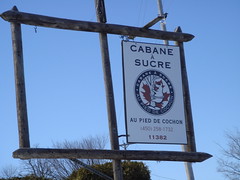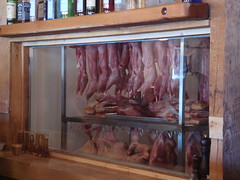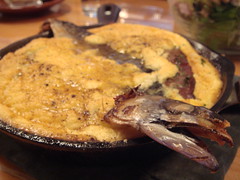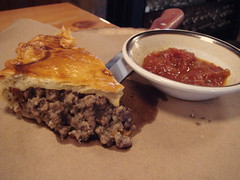While researching our trip, we read that Chef Martin Picard of Au Pied de Cochon had purchased a cabane à sucre and would be opening it the very same week we would be in Montréal. We were initially unsure as to whether we should go — it was outside the city, we’d have to rent a car, could we schedule it in — but then a friend pointed out that the convergence of our trip, Chef Picard’s new venture, and the sap flowing was just too serendipitous to pass up. We made a reservation and booked a rental car.
And so it was that we dragged ourselves out of bed to hit the road to Cabane à Sucre Au Pied de Cochon.
We pulled up to the cabane, which was of course a shack along a rural road, with its expected shacklike appearance. Inside, it was full of exposed beams, wooden picnic-like tables, and that general rustic feel.
But as we sat down and started to look around, we realized just how much money had been put into renovating and furnishing the place. Yes, the bar was wooden, but it had a thick, shiny, new coat of varnish. The “shack” had full water and power and a credit card terminal. The bar featured 6 taps and a wide selection of new glassware — pint and half-pint steins, wine glasses, tumblers, and martini glasses (!!) — not to mention a shiny new espresso machine. Staff were turned out in casual but uniform logoed shirts and confident and professional in spite of it only being the restaurant’s 3rd day of business. The whole place was very polished and I guess a sign of what a Chef with money and recognition can do with, and to, a new facility.
And then there was this, a window into the fridge, facing out from behind the bar. Inside hung rabbits, sausage, and hunks of poultry; also visible were heads of pig (and one unidentified animal), as well as vacuum-sealed bacon. What an first impression — a window into their fridge and into possible future dishes. The rabbits had me especially excited; unfortunately, they didn’t make an appearance at the table.
We were offered coffee and took a latte and a cup of drip. I tried a sip of coffee — excellent — then reached for the handy vial of maple syrup. Now, I normally take my coffee black, but hey, this was my first time being offered maple syrup as a sweetener. In addition to sweetening the coffee, it added a warm, inviting undertone that I much preferred to the stark piercing sweetness of white sugar. And the latte was exemplary — pure, clear flavours — no syrup needed there.
Food at the cabane is served from dim sum carts, plated to share family-style. The menu is unannounced and unposted and changes daily; all diners get the same dishes.
They started us with bowls of soupe au pois — split pea soup, a Québécois classic. Their version was elevated by the inclusion of foie gras and was very polished for such a rustic dish. Even after 2 meals at Au Pied de Cochon, this dish was the best use of foie gras I’d encountered all week. Definitely the best dish out of everything we were served.
Then came cretons (a pork pâté similar to rilettes) and smoked salmon with pickled onions. We took them on crêpes au sarrasin, buckwheat pancakes kissed lightly by maple syrup. As we ate, more plates continued to hit the table, and we struggled to keep up while photographing each new offering.
Next was a mackerel omelette, with a whole fish fried into the eggy cake, head and tail protruding from the pan. The omelette was deep and thick and about twice the size it needed to be for the 2 of us. The oily mackerel, combined with the egg and big chunks of potato, was just too heavy and we only managed to finish half the pan. I can see the dish working better on a colder day, or at dinner instead of lunch.
Salad followed, but no low-cal mercy at the cabane. Instead we had salad with ham and walnuts and oreilles de crisse (deep-fried pork rinds). The salad contained a bit too much parsley, and (inevitably) too few oreilles, but was dressed with just the right amount of mustard, perking it up and adding interest without drowning the other flavours out. A very successful harmony among assertive and potentially dissonant ingredients.
And another traditional Québécois dish — tourtière. This one was made with both ground pork and contrasting larger chunks of pork. It was served with a vinegary house-made ketchup that gracefully cut the pie’s richness. But the real star of the dish was the pastry — flaky, buttery, rich, and absolutely top-notch. Tourtière, like soupe au pois, isn’t a dish I can get at home, so I was excited to see it hit the table. Also like the soup, this was amazing.
The next course was the diametric opposite of traditional. We were served a deep-fried maki of lobster, foie gras, and beet; even more surprising was the accompanying dipping sauce of soy and maple syrup. Unfortunately, the dish was just trying to do too much — premium ingredients that didn’t work well together, and a complex concept and technique that neither brought the ingredients together nor enhanced them.
And finally, finally, we were presented with the main course, a huge serving platter featuring magret de canard and what they called the “royal family” — a trio of meats comprised of duck, quail, and Cornish hen. The magret was the best of the dish, served on a bed of beans (with lard, naturally). And of course the beans were improved by a drizzle of maple syrup. The royal family was just a bit too much — by this point in the meal, the 3 meats were kind of running together and there’d already been too many strong flavours for these 3 more to really stand out. The trio was served on a bed of cheesy grits, too cheesy for my taste.
We’d survived the savoury courses and only dessert remained. In front of us sat a banana split made with maple ice cream, candied nuts, toasted homemade (?) marshmallows, maple “honeycomb” (think Crunchie bar), bananas and chocolate syrup, topped with maple cotton candy. The highlight was definitely the ice cream: clear, strong maple taste without being at all too sweet. The other elements were really just footnotes compared to the ice cream.
Cabane à Sucre Au Pied de Cochon was a fantastic meal and a ton of fun. I wholeheartedly recommend making the drive if you’re in the area — if I lived in Montréal I would go each time the season rolled around.
The meal at the cabane was like what my 2005 meal at Au Pied de Cochon had been (and what our APdC visits this trip hadn’t) — cooking with clarity of purpose and flavour, experimental in a successful, progressive way, but grounded in technique and tradition. The meal’s greatest successes were the soupe au pois and the tourtière — 2 classic Quebecois dishes; simple, rustic dishes, refined to a very high level.
After the season ends, the cabane will end its run as a dining room (on 19 April). It’ll then be used as a sandbox kitchen, in addition to acting as a producer of maple syrup and a production kitchen for Au Pied de Cochon downtown.
Rereading the Au Pied de Cochon book the other day, I noticed a blurb in which Chef Picard expressed his dream to one day buy a sugar shack and there make maple syrup and experiment in the kitchen. In 2009, that dream has come true, and it’s not only beautiful, but delicious too.
- Cabane à Sucre Au Pied de Cochon 11382, Rang de la Fresnière, St-Benoît
More from Cabane à Sucre Au Pied de Cochon
[flickr-gallery mode=”photoset” photoset=”72157615788381687″] [flickr-gallery mode=”photoset” photoset=”72157615955150180″]





April 21, 2009 at 12:21 am
;P And what rating would you give the CaS? JK! JK!!
You know, from the flickr pictures, I was already captivated. I still can’t get over your meal. My taste buds can only imagine how fantastic it really was.